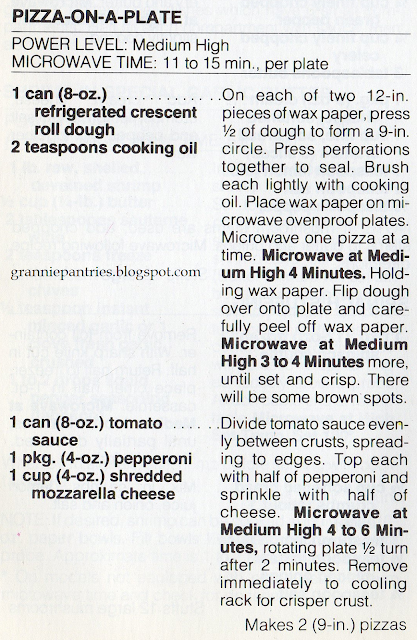Poppy: It's getting hot, so you know what that means!
You (whispered quietly to yourself): Poppy will try to tie the introduction into the concept of summer heat using a flimsy premise.
Poppy: No-- Well, yes, obviously, but that's not the answer I was looking for. It's time to do what any moderately well-to-do '70s cook would do: Consult a microwave cookbook. Less cooking time, no burners, no oven cranked up to 450℉= Cooler house! Today's specimen is Guide to Microwave Cooking and Recipe Book (Hotpoint/ General Electric, 1979).
You know the thing I just said about reduced cooking times? Well... That was usually a selling point for microwaves. They could cook meals in a fraction of the time of conventional cooking. Hotpoint and General Electric didn't necessarily see this as the biggest selling point, though. As far as they were concerned, cooks might just want to use the microwave in place of the slow cooker.
This minestrone is definitely NOT a convenience recipe! First cooks have to simmer bones for 8-12 hours to make the stock in the microwave. Then they have to add all the other ingredients to the stock once it's prepared and microwave for another 6-8 hours. It just seems to me like this makes the same questionable assumption as an earlier edition: people who buy microwaves are not all that interested in convenience.
"Well, Poppy," you might say, "Maybe they just want to see how a microwave would work as a slow cooker. There's not that much actual work involved. Most of the recipe just consists of leaving stuff in the microwave for a really long time."
Perhaps, but I'm also not sure the cooks who are in the market for kitchen convenience are the same ones who might want this recipe.
Short ribs and homemade noodles? I thought the whole reason 1970s cooks were willing to spend so much money on microwaves was that they were not the types of people who wanted to spend time making homemade noodles. They wanted convenience. Why make homemade noodles when big bags of pre-made were so cheap (especially if you were just going to microwave them anyway)?
Of course, the book does have some things for cooks who wanted convenience, like pizza on a plate!
And if you're wondering how appetizing refrigerated crescent roll dough, microwaved into supposed crispiness and then topped with pizza toppings might look, here's your answer:
"Since it starts with triangles of dough, Pizza-On-A-Plate may be slightly irregular, but quick and good," proclaims the caption. The slight irregularity is not the issue, though. As someone who likes my pizza cheese to be browned to about three seconds shy of burned, that sad, clumpy mozzarella makes me doubt the "good" part. (And never mind that the crust is likely to be more rubbery than crispy.)
My favorite picture in the entire book might be the picture for an entire microwave meal menu, though.
What's so great about the visual of the pretty boring-sounding Meatloaf Dinner?
I love that the meatloaf and the dessert look almost identical! If you just quickly glanced at the page, I bet you'd be hard pressed to tell which one is the Lemon Lovers' Meatloaf and which one is the Apple Graham Pie. (Key: The apple pie is a slightly lighter shade of brown, and the meatloaf has lemons lacquered on top.)
Should you ever need to make sorta-matching main dish and dessert, here are the recipes:
At least these two seem like they're not too much trouble, and they'll actually keep the house cooler on a hot day than traditionally baked versions would. Whether they actually taste like anything (because of the lack of browning) is a separate question, but hey, at least they seem a little more like realistic options for 1970s microwave cooks! Now I'm off to NOT put something in my microwave for 12 hours. (I don't think I could set the timer for 12 hours!)









I was also wondering how you could set a microwave to run for 12 hours. Along with visions of the liquid boiling over at some point, because that's what usually happens in microwaves when you leave liquid in there for too long. It's a good thing that they added peas and carrots to that meatloaf recipe, otherwise everything is the same color! The meat, the dessert, the baked potatoes, brown brown brown. I'm also glad you pointed out which was the pie and which one was the meatloaf. I couldn't figure it out from the picture alone. Interesting that they used a microwave for this considering crockpots were totally around during the 70s.
ReplyDeleteWhile the pizza on a plate is pretty sad, I could see myself wanting it as a kid because it was pizza. After all, pizza was one of the few meals I looked forward to as a kid.
I imagine crockpots would have been a lot more energy efficient, too, and that should have seemed appealing in the '70s.
DeleteThat's true about the pizza. Any sad version of it would probably be better than whatever else mom had planned. (Definitely better than ham, potatoes, and green beans boiled into oblivion.)